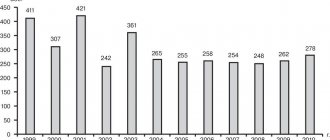The gangrenous form of appendicitis is the most dangerous type of this disease, and the postoperative period sometimes drags on for several months. If you contact a doctor late or incompletely remove the inflamed appendix, numerous complications arise, which, if not treated in a timely manner, lead to death.
To protect yourself and your loved ones from negative developments, you need to know why gangrenous appendicitis occurs, what its symptoms are, what treatment tactics doctors follow, and what the postoperative period should be like.
How long does the postoperative period of gangrenous appendicitis last?
It is impossible to give a definite answer to this question, since much depends on the stage of the disease, the success of the surgical intervention, the age of the patient and the presence of postoperative complications.
In a situation where the removal of the appendix went without complications, the suture was processed properly, and the patient followed all the recommendations of the attending physician, then you can leave the hospital 2 weeks after the operation. Weakened patients, the elderly and children are kept under observation for about a month to avoid complications.
In cases where complications arise after removal of gangrenous appendicitis, the postoperative period may drag on indefinitely. Everything will depend on the treatment performed, the dynamics of the patient’s condition and subsequent rehabilitation measures.
What is acute gangrenous appendicitis?
Acute gangrenous appendicitis is a type of purulent inflammation of the appendix, which is based on irreversible destruction (destruction) of its wall. Therefore, it is classified as one of the types of destructive appendicitis.
Such a diagnosis can be established only after an intraoperative visual assessment of the appendix: against the background of a sharply edematous, loose wall covered with fibrin and purulent layers, areas of dark-colored necrosis are identified.
Any manipulation with a gangrenous appendix ends in its rupture.
Reasons for the development of the condition
The gangrenous form of appendicitis occurs when the patient does not promptly seek medical help with the initial signs of inflammation in the cecum of the intestine.
If surgery is not performed in the first 24 to 48 hours, the tissue of the appendix begins to die, its cavity is filled with purulent masses. The pain becomes a little less.
Symptoms of the disease
The presence of gangrenous appendicitis can be suspected by the following manifestations of the disease:
- children become lethargic and whiny, complaining of abdominal pain;
- the patient refuses to eat, he often has the urge to vomit;
- defecation disturbances are observed, patients complain of diarrhea and constipation;
- the stomach becomes hard to the touch, flatulence increases;
- In patients, the temperature rises to 39 degrees, chills are observed;
- a yellow or brownish coating appears on the tongue, a feeling of dryness appears in the mouth;
- patients complain of general weakness and loss of strength.
In some cases, patients note that the pain has become less. This symptom does not bode well, since at this time the necrotic process in the appendix has affected the nerve endings and tissue death intensifies.
The danger of gangrene of the appendix
The main danger of the gangrenous form of appendicitis is that if the festered appendix is not removed in a timely manner, its contents will enter the abdominal cavity, causing an inflammatory process in the internal organs. The risk of developing sepsis in this case is also high.
Another danger is that the risk of postoperative complications with this form of the disease is much higher. Often, patients experience peritonitis and internal bleeding, and if the inflamed appendix is not completely removed, the process can begin again.
Causes of gangrenous appendicitis
The etiopathogenesis of gangrenous appendicitis is determined by the mechanism of inflammation in the appendix. Risk factors for the development of the primary gangrenous process are:
- Senile age and age-related changes in blood vessels;
- Childhood and congenital hypoplasia of the appendicular arteries;
- Atherosclerotic damage to the walls of the intestinal arteries;
- Formation of blood clots in the arteries and veins of the appendix;
These data suggest that the immediate causes of acute gangrenous appendicitis are microcirculatory disorders. Their result is a violation of blood circulation in the appendix and, as a consequence, its necrosis (gangrene). All other elements of pathogenesis: infection, impaired outflow of appendicular contents, auto-aggression of immune cells are added secondarily, aggravating the course of the process.
It also happens that the cause of gangrenous appendicitis is the transition of simple forms of appendicitis (catarrhal and phlegmonous) into destructive ones with inadequate and untimely surgical treatment. In this case, the appendix simply undergoes purulent melting.
Can there be complications after surgery?
The following complications often occur:
- the occurrence of abscesses in the abdominal cavity;
- fistulas and intestinal obstruction;
- peritonitis;
- internal or external bleeding;
- aseptic thrombophlebitis.
The reason for their occurrence is that patients do not immediately get to the operating table, while destructive processes in the abdominal cavity are actively developing. In this case, incomplete removal of the affected process of the cecum threatens repeated inflammation and new surgical intervention.
Consequences of gangrenous appendicitis
If gangrenous appendicitis is operated on before spontaneous rupture of the appendix, then this does not threaten the patient. The only thing that occurs a little more often than with other forms of appendicitis is suppuration of the postoperative wound.
But if the operation is refused, severe consequences develop in all cases:
- Perforation of the appendix with leakage of purulent contents and feces into the abdominal cavity;
- Self-amputation of the appendix (its complete separation from the cecum);
- Purulent and purulent-fecal peritonitis;
- Abdominal sepsis;
- Multiple abscesses of the abdominal cavity and pelvis;
- Sepsis and pylephlebitis (spread of purulent infection into the systemic bloodstream).
All these conditions are characterized by a progressive and fulminant course and cause extremely severe intoxication with multiple organ failure. Such pathological changes result in irreversible disruption of the functioning of vital systems and the death of the patient.
Features of recovery after surgery
Full recovery of the patient after surgery is of paramount importance. To ensure that the rehabilitation period goes as smoothly as possible, patients are given the following recommendations:
- Exercise therapy and breathing exercises under the supervision of a doctor. Thanks to this, stagnation does not occur in the body, and such a dangerous complication as fusion of sutures with the walls of internal organs is avoided.
- Ban on water procedures. Until the seams completely heal, patients are advised to wipe themselves with wet wipes or a towel soaked in water.
- Regular inspection of stitches, their antiseptic treatment and dressings. Keeping the wound in good condition promotes its rapid healing and prevents the development of inflammation and suppuration.
- Monitoring body temperature and blood counts. When the temperature rises or the number of leukocytes in the blood increases, an inflammatory process in the body is suspected.
It is important to remember that even after the patient has had the stitches removed and discharged home, rehabilitation continues. Depending on the severity of the disease and the patient’s health condition, the doctor may prohibit sunbathing, swimming in pools and open water, and engaging in certain sports for some time.
These recommendations should be taken seriously, as ignoring them will lead to the development of complications.
Introduction
Surgical treatment of appendicitis was developed and introduced at the turn of the 19th and 20th centuries. In the first quarter of the 20th century, surgical treatment replaced conservative therapy.
During the same period, many scientists, fascinated by Darwin's ideas, enthusiastically looked for rudiments in the human body. The initial list included about 180 rudiments. Enthusiastic practitioners, following the theorists, quickly solved the problem of rudiments in an operational way. The intestines were especially hard hit: it was even practiced to remove the colon, since it was believed that thereby the body was freed from putrefactive bacteria.
Moreover, they did not stand on ceremony with the appendix; it was removed along the way so that it would not create problems in the future [4].
As knowledge about the functions of organs accumulated, the list of rudiments was reduced to zero. The vermiform appendix, which performs complex and important functions, has also been rehabilitated.
Functions of the appendix
The appendix is a lymphoid organ. The walls of the appendix have a significantly larger number of lymphoid formations than other parts of the intestine. Thus, in the last months of uterine life, 5-7 lymphoid follicles (LF) per 1 cm2 are detected in the wall of the cecum and the appendix. In childhood and adolescence, the number of LF in the appendix increases to 50-60 per 1 cm2, and in the cecum remains at the same level. An increase in the number and size of LF in the wall of the process occurs up to 16 years. The total number of LF in the appendix in adolescents is on average about 655, which is 11/2 times more than in the walls of the esophagus, and only 50% less than the total number of LF in the small intestine. In old and senile age, a decrease in the number and size of LF is observed.
The LF is divided into a dome, a crown, and a germinal center. The peripheral part of the nodule is occupied by the (mantle) T-zone, where the ratio of T- and B-lymphocytes varies from 14:1 to 20:1. B-zone: IgA- and IgM-producing lymphocytes are found in the central parts of the LF, IgG - in the periphery. The appendix is an important organ for the formation of B-zones of the immune system organs in ontogenesis and is involved in immune reactions. Newly formed lymphocytes and antibodies are not only used at the site of their origin (appendix), but also spread along the vascular bed, reaching the thoracic duct, lymph nodes and spleen [10, 22].
Through the epithelium covering the LF of the process, constant migration of lymphoid cells occurs. In 1 minute, from 18 to 36 thousand lymphoid cells enter the intestinal lumen [12].
The appendix performs a secretory function, secreting appendicular juice in an amount of 0.8 to 3.5 ml per hour, its pH is 8.3-8.9 (alkaline). The secretion contains sialic acid, which performs a protective, bactericidal function [12]. The process has a very rich innervation. Its nervous apparatus contains not only mature nerve formations, but also immature ones - neuroblasts, which indicates the continuous renewal of the nervous apparatus throughout life [8].
The lymphoid apparatus of the appendix can act as a reserve immune organ due to resistance to damaging factors that cause dysfunction in other parts of the immune system [4, 24].
Appendectomy to some extent reduces both the risk of Crohn's disease and ulcerative colitis and the severity of their course [29]. After removal of the appendix, the engraftment of transplanted organs is better - these are all examples of immunosuppression that occurs after appendectomy [24].
The ileocecal region includes the appendix, the cecum with the bauhinian valve, and the terminal portion of the ileum. The loss of any link in this system not only inevitably introduces changes into its statics, but also causes significant functional disorders. The role of the ileocecal region in the digestive process is very important. It differentiates the volume of chyme and the time of its entry into the large intestine, and has a significant impact on the motor activity of the entire digestive system [9].
Severe intestinal infections and ongoing antibacterial therapy can “cleanse” the intestines of beneficial bacteria, and then the vermiform appendix comes to the rescue. “The appendix is a reliable repository for bacteria” - this is the opinion of W. Parker, one of the researchers of the function of the appendix (Duke University, USA, 2009). The shoot is a kind of “farm” where beneficial microflora and, above all, E. coli multiply. From the appendix it constantly enters the large intestine, where it prevents the proliferation of pathogenic flora [26, 35].
The vermiform appendix performs an endocrine function, secreting a number of enzymes that affect the digestive processes and the activity of other abdominal organs [21, 24]. Removing a normal appendix from a pregnant woman increases the risk of miscarriage by 3 times [17].
Acute appendicitis
Acute appendicitis (OA) is a nonspecific infectious inflammation of the appendix.
Etiology and pathogenesis of acute appendicitis
The development of OA is associated with two factors: obstruction and infection. Obstruction of the appendix is detected in 30-40% of patients with OA; it is caused by foreign bodies, fecalitis, etc. Obstruction of the appendix causes an increase in intra-appendiceal pressure, leading to compression of blood vessels, the development of ischemia, and disruption of mucosal trophism, which ultimately activates the autoflora in the appendix. In 60-70% of cases, the onset of OA is associated with a viral infection, which, by damaging the mucous membrane of the appendix, makes it more vulnerable to colonization by bacteria [6, 36].
Infection always causes significant hyperplasia of the LF, which sometimes leads to complete obstruction of the process without the participation of foreign bodies [6, 8].
The role of infection, in particular viral, as well as immunological aspects in OA are reflected in the dissertation work carried out by A.E. Ali-Rizoy.
Etiological verification:
In 79.5% of patients, viral-bacterial was detected, in 7.7% - only bacterial (Escherichia coli, Klebsiella, Pseudomonas aeruginosa), in 12.8% - only viral (influenza viruses, paramyxoviruses, enteroviruses, adenoviruses, and the most frequently detected orthoviruses and paramyxoviruses) infection.
Immunomorphological study
appendage in OA revealed a significant decrease in the level of IgA- and IgM-containing cells, especially in phlegmonous OA, as well as an increase in the level of IgG and a sevenfold increase in the level of IgE, which may indicate the participation in the pathogenesis of OA and the allergic component, which helps limit the area of action of the antigen [2 ,13].
Classification of acute appendicitis
There are more than a dozen classifications written by surgeons, and only a few classifications written by pathologists.
Which specialists should have priority in creating new classifications—clinicians or pathologists?
Already at the time of his first acquaintance with appendicitis, McBurney wrote that “it is impossible to make a diagnosis of pathological changes in the appendix on the basis of clinical data.” According to pathologist P.F. Kaliteevsky, “it is impossible to clinically determine the form of OA... with certainty not only before surgery, but also based on the appearance of the appendage. And only a pathologist with the help of a microscope, sometimes with great difficulty, can achieve this” [11].
Monographs written by clinicians provide the following classification of OA: catarrhal (superficial, simple), destructive (phlegmonous, apostematous, phlegmonous-ulcerative, gangrenous, perforated) [12, 15, 18].
Although clinicians call their classifications clinical and morphological, the material presented by pathologists is often presented inaccurately. For example, in classifications written by clinicians, catarrhal and simple (superficial) appendicitis are identified, although pathologists separated them. Thus, I.V. wrote clearly and clearly about catarrhal appendicitis. Davydovsky: “Catarrhal appendicitis, as a rule, is not related to classical appendicitis and is not, as previously thought, either the initial phase or the form of the latter... Most likely, there is a reflection of the general catarrhal state of the large intestine or part of it” [ 8]. A.I. Abrikosov in his classification, which was and remains the most successful of all those written, did not single out catarrhal appendicitis [1].
I. Superficial appendicitis is a primary affect.
II. Phlegmonous appendicitis:
1) simple phlegmonous;
2) phlegmonous-ulcerative;
3) apostematous: a) without perforation, b) with perforation.
III. Gangrenous appendicitis:
1) primary gangrenous: a) without perforation, b) with perforation;
2) secondary gangrenous: a) without perforation, b) with perforation.
Next we should touch on the forms and stages of OA.
In the 70-80s of the last century, a controversy arose between surgeons. Some began to deny the stages, highlighting only certain forms of appendicitis, others recognized the stages, but denied individual forms. The discussion was mainly carried out by clinicians, unfortunately, without relying on the work of pathologists [14, 16].
I.V. Davydovsky identified two forms of OA: “By forms we should mean special features of the process, its deviation from typical development either from the very beginning or in the further course. This includes gangrenous appendicitis (GA), as well as abortive forms of appendicitis, limited to the formation of a number of superficial primary affects without their further development into ulcerative and phlegmonous processes” [8].
Research in recent years confirms this point of view. Thus, according to the hypothesis of Edward Livingstone (University of Texas, USA, 2009), perforation of the inflamed appendix does not always occur, regardless of how much time has passed from the onset of the disease. Non-perforating inflammation of the appendix is associated with a viral infection [36].
The inflammatory process often begins in the distal part of the process, where the primary effect is microscopically revealed in the form of a defect of fibrin and leukocytes. This is how simple (superficial) OA arises [1, 8]. Macroscopically, the process is not changed, so it is clinically difficult to distinguish the onset of OA with structural focal changes in the form of a primary affect from secondary, reactive changes that occur with diseases of the intestines or other organs [11].
At this stage, simple appendicitis is the initial stage, and with spontaneous resolution it is a separate form.
If the process progresses, then several primary affects merge and all layers of the process become infiltrated with leukocytes. This stage is designated as simple phlegmonous (according to A.I. Abrikosov) appendicitis. These are stages of two stages without destructive phenomena. O.E. also writes about this. Nifantiev: “When it comes to simple phlegmonous appendicitis, a morphological form is assumed that is not accompanied by tissue destruction” [15].
With simple phlegmonous appendicitis, you can see slight hyperemia and minimal swelling; on palpation there is tension, rigidity. This stage is diagnosed with ultrasound examination, especially with laparoscopy. The sensitivity of ultrasound in verifying appendicitis is about 80%, the specificity is 85%. Videolaparoscopy provides visualization of the appendix and the correct diagnosis in 98.1% of cases [20, 21, 27].
With further progression of OA, destructive variants develop: phlegmonous-ulcerative, apostematous, process empyema.
Any variant of destructive appendicitis can be accompanied by massive hemorrhages into the wall and into the lumen of the appendix. Then it has a dark red, greenish-red or black-red color. The “gangrenous” appearance of the appendix is caused by changes in blood pigment under the influence of intestinal gases, mainly sulfur-containing gases [11].
Initially developing GA proceeds without previous stages. It occurs as a result of angioedema, which leads to necrosis and gangrene (primary GA) and is rare, or due to inflammatory thrombosis of the vessels of the appendix, which also leads to its gangrene (secondary GA) [1, 8]. On examination, the appendix appears flabby, greenish-gray or black, and emits a putrid odor [11].
Recovery processes after acute appendicitis
P.F. Kaliteevsky o [11].
Description I.V. Davydovsky significant restoration of the appendix in case of severe destruction: “The slowdown in regeneration may be associated with the intensity of phlegmonous and ulcerative lesions... Diffuse phlegmonous-ulcerative appendicitis leads to purulent melting of the mucous membrane. The further developing granulation tissue leads to the formation of diffuse scar fields, overlapping on the lumen side with new columnar epithelium” [8]. Lymphoid tissue is also restored: “New formation of lymphoid tissue in the form of lymphatic follicles ... occurs along the connective tissue layers ... in the wall of the appendix” [7].
The following excerpts describe the ability of the appendix to recover from OA. But the question arises whether the risk of developing recurrent or chronic appendicitis remains.
As for recurrent appendicitis (RA), no one denies it.
Recurrent and granulomatous appendicitis
The cause of RA may be delayed appendectomy due to appendiceal infiltrate (AI) or appendiceal abscess (AA) [17]. Histomorphological examination of the appendix in RA reveals signs of a prolonged inflammatory process, and sometimes granulomas, which are known to be characteristic of granulomatous appendicitis (GRA) [33]. Thus, there is a certain relationship between RA and GRA. Let's touch on it in more detail.
There are idiopathic granulomatous appendicitis (IGA), which includes GRA without an established etiology, and secondary granulomatous appendicitis (SGA), which is GRA with a known etiology. Over the past decade, GRA has been well studied, which has made it possible to more often diagnose CAA and extremely rarely diagnose IHA. It should be noted that HAV is also detected infrequently. Thus, according to Abdull Gaffar B. (2010), IAV was diagnosed in 13 processes removed and examined in 3381 patients with a clinical picture of OA, which amounted to 0.38% [28]. The frequency of CAA in diseases: 25% are patients with yersinia ileitis and appendicitis, 15% are patients with AI and AA with delayed appendectomy, 8% are with Crohn's disease, the remaining observations are for sarcoidosis, foreign bodies, mycobacteria, fungi, parasitic invasion. In general, if in the USA and Western Europe yersinia infection and Crohn's disease dominate in VRA, then in tropical and subtropical countries mycobacteria and parasitic invasions predominate [28, 29].
HAV in RA remains not fully studied. For example, it is unclear what etiological factor initiates the development of granulomas, which are detected in 30% of patients with RA, while 70% do not have them [31]. It is possible that the two histomorphological variants of RA are caused by different pathogenic flora. Is there research being done in this direction?
When studying GRA in an experiment on rabbits conducted in Japan (H. Fujjwara, Tokyo, 1987), Gr (+) bacteria were identified in the granulomas, with which the development of granulomas was presumably associated [30]. In humans, a similar flora has not yet been isolated in GRA.
The information is interesting because if the participation in the development of the granulomatous variant of RA of a causally significant microbial pathogen, which would belong to the microflora of the appendix, is demonstrated, the possibility of transition of OA to RA and then to chronic appendicitis (CA) would be proven. But this is only one of the hypotheses. You can put forward another one. For example, we cannot exclude the possibility of identifying granulomas in RA due to the development of OA against the background of already occurring GRA.
RA without granulomas proceeds favorably. In more than 90% of cases, its significant recovery occurs already in the first weeks from the onset of the disease, which eliminates the risk of chronic RA [33].
Thus, IAV is one of the manifestations of infectious and immune diseases, often occurring with damage not only to the appendix, but also to other parts of the intestine, which indicates that the isolation of this variant of appendicitis is conditional.
There is also acute recurrent appendicitis, the diagnosis of which is made in patients with a clinical picture of OA and a history of similar attacks that resolve on their own. Previous exacerbations are interpreted as “relapses” of appendicitis [17].
This may be true, but it is necessary to clarify: repeated “relapses” are caused by a viral infection in 10-12.8% of patients with a clinical picture of OA [2, 36]. They end either with the next spontaneous recovery at the stage of superficial appendicitis with complete restoration of the appendix, or they pass into the phlegmonous stage of OA [8, 32]. In essence, we are faced with another episode of OA, rather than another relapse of OA.
Summing up the chapter on RA, it should be noted that neither RA, nor especially OA, transform into CA. Literary sources proving the existence of CA provide histomorphological and cultural data that are not typical for exacerbation of a chronic inflammatory process caused by infection. There are no descriptions of either neutrophil infiltration or activated microflora in the appendix [8, 11, 19, 23, 25].
Are there other options for the development of CA?
Primary chronic appendicitis
Primary recurrent or primary chronic appendicitis (PCA) is distinguished, developing initially as a chronic process, without a history of OA.
The changes detected by pathologists in PCA are varied: from minimal initial manifestations in 7.4% of patients to more pronounced sclerotic changes in the submucosal layer, which are usually accompanied by lymphohistiocytic infiltration in 42% of patients, to atrophy and sclerosis with complete obstruction of the process in 50.6 % of patients [11, 34]. This option also includes the one described by A.A. Rusanov “fibroplastic appendicitis” with abundant growth of connective tissue in the wall of the appendix and the spread of the process to the cecum, ileum, ascending colon, and parietal peritoneum [18].
Pathologist Obendorfer “has never seen obliteration due to acute inflammation of the appendix,” and the pronounced “sclerotic changes in the appendix are of a chronic inflammatory nature” (cited by P.F. Kaliteevsky [11]).
Thus, PCA is characterized by a fibroplastic process, the etiology of which is unknown.
If there is no evidence of the involvement of infection in the development of sclerotic changes, then what causes them?
In PCA, immune complexes are sometimes found in the endothelium, vessel walls, and perivascularly [19]. A.I. Abrikosov, in the processes removed during the “cold period,” along with sclerotic changes, found changes in small arteries such as “periarteritis nodosum” and did not exclude the allergic genesis of relapses of appendicitis [1]. Similar changes in blood vessels were described by I.V. Davydovsky [8].
It should be noted that the described histomorphological dynamics in PCA are more typical for immune-mediated processes: chronic glomerulonephritis in nephrology, autoimmune gastritis in gastroenterology, etc. [3].
How effective is appendectomy for PCA? According to R.E. Berman, V.K. Vaughan, only in some children the condition improved, but in the majority the pain persisted [5]. According to other data, in 13-63.2% of patients the result of the operation was unsatisfactory [19].
All of the above allows us to put forward a hypothesis about the autoimmune genesis of the development of PCA involving the entire ileocecal zone, and most likely it has nothing to do with OA.
To confirm it, it is necessary to conduct electron microscopic and immunohistochemical studies.
Thus, the appendix performs complex functions: immune, secretory, hormonal, normalizes flora and affects intestinal motility.
The cause of recurrent appendicitis may be delayed appendectomy with appendiceal infiltrate and appendiceal abscess. In a third of patients, granulomas are detected, which indicates a possible relationship between recurrent and granulomatous appendicitis.
The existence of chronic appendicitis is not confirmed by histomorphological and cultural studies. During its exacerbation, signs of inflammation caused by infection are not detected. There are no descriptions of either neutrophilic infiltration or activated microflora in the appendix.
Primary chronic appendicitis most likely has no relation to acute appendicitis, but occurs as an independent autoimmune disease of the appendix and ileocecal region. To confirm this hypothesis, it is necessary to conduct electron microscopic and immunohistochemical studies.
Diet
For the first half day after the operation, the patient can gradually drink still water or weak sweet tea; eating is prohibited. On the second day, the patient is given low-fat broth, liquid porridges and purees, and finely chopped boiled meat are gradually introduced into the diet.
In the following days, baked vegetables and fruits, fermented milk products, stewed or boiled fish dishes are carefully introduced into the diet. Be sure to drink clean water in an amount of at least 1.5 liters per day.
It is important to monitor not only the quality of your diet, but also adhere to the following recommendations for better absorption of food:
- meals should be fractional, the patient should be fed at least 5 times a day at regular intervals;
- food should only be warm; eating hot or cold foods is prohibited.
For the first six months after surgery, it is important to adhere to the principles of dietary nutrition and give preference to lean varieties of meat and fish, and the basis of the diet should be boiled, baked without oil or stewed dishes.
How to protect yourself from illness
There is no way to prevent gangrenous appendicitis. To reduce the risk of developing the disease, you should follow some recommendations:
- consult a doctor promptly if you suspect an acute form of the disease;
- treat gastrointestinal diseases;
- monitor the condition of the cardiovascular system;
- If you are predisposed to the formation of blood clots, undergo examination and follow all recommendations of your doctor.
Gangrenous appendicitis, if its course does not have complications, and the patient follows all the recommendations of the attending physician in the postoperative period, has a favorable prognosis. The situation worsens if postoperative complications are added to the disease, since in this case the risk of death is high.
Recommended video:
In order to quickly recover from surgery and avoid the development of complications, it is important to strictly follow all the instructions of the attending physician, do not rush to fully engage in sports and be sure to adhere to dietary nutrition for a speedy recovery of the body.
Treatment
If there are still opinions about the possibility of conservative treatment for catarrhal appendicitis, then the gangrenous and gangrenous-perforated form can only be cured surgically. To stop the spread of the inflammatory process to the peritoneum, it is necessary to remove the source of pus.
The operation is most often performed for emergency indications 2–4 hours after the onset of the attack
A planned approach at a later date is possible, but it should rather be called a “deferred” approach. Time is spent on stabilizing the patient’s condition in case of a drop in blood pressure, heart failure caused by intoxication, or decompensation of diabetes mellitus.
In preparation for surgery, patients are detoxified, fluids, antibiotics, and cardiac support are administered by drip. The contents of the stomach are removed through a tube. Doctors must find out whether the patient is prone to allergic reactions.
This is important to know when choosing a method for treating the surgical field and anesthesia. The patient must sign his consent to undergo surgery; parents or guardians do this for the children.
For complete pain relief, one of the following methods is used:
- creation of anesthetic infiltrate;
- conductive block of the nearest nerve plexuses;
- general anesthesia.
It is chosen by the anesthesiologist depending on the patient’s age, excitability, and drug tolerance. Sufficient pain relief helps reduce the time of surgical intervention, the risks of postoperative complications, and complete healing.
Local anesthesia is not used in children; fear and excitement do not allow them to completely relax the abdominal wall and examine the cavity. For adult patients, local anesthesia for catarrhal appendicitis is sufficient, but possible peritonitis and the need to expand the operation for gangrene require general anesthesia. Because it suppresses the gag reflex, it relaxes the muscles when muscle relaxants are administered.
After treatment of the surgical field and anesthesia, the surgeon performs a layer-by-layer dissection of the peritoneal wall. The method allows you to close bleeding vessels and injure less muscles. The length of the incision should be sufficient to allow the doctor to examine the cavity. The muscles and their aponeuroses are separated along the fibers manually.
The omentum and intestines are brought into the open abdominal cavity. The inspection requires checking 50 cm of length on each side of the appendix. The inflamed appendix is identified by the beginning of the bands of the large intestine.
The process is isolated very carefully so as not to cause spontaneous rupture
The appendix is removed, and the remaining stump is sutured with a special sealed purse-string suture. It consists of immersion inside and the possibility of connecting the serous membranes. If effusion is detected in the peritoneum, it is washed with sterile solutions and an antibiotic is administered. The patient's abdominal wall is sutured using dense threads that dissolve after some time.
7–10 stitches are applied to the skin. The need to combat peritoneal phenomena requires leaving a drainage tube. Once the patient's condition has stabilized, the drainage is removed. The operation usually lasts up to three hours. There are no special standards. The time is determined by the severity of the condition, age, complicating factors (adhesions in the abdominal cavity, abnormal location of the appendix).










